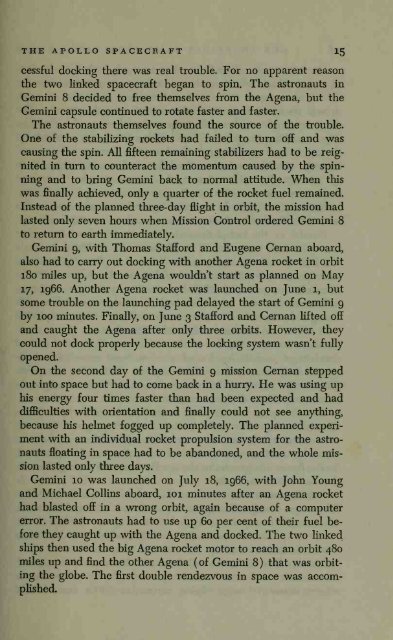Create successful ePaper yourself
Turn your PDF publications into a flip-book with our unique Google optimized e-Paper software.
THE APOLLO SPACECRAFT 1$<br />
cessful docking there was real trouble.<br />
For no apparent reason<br />
the two linked spacecraft began to spin. The astronauts in<br />
Gemini 8 decided to free themselves from the Agena, but the<br />
Gemini capsule continued to rotate faster and faster.<br />
The astronauts themselves found the source of the trouble.<br />
One of the stabiHzing rockets had failed to turn off and was<br />
causing the spin. All fifteen remaining stabilizers had to be reignited<br />
in turn to counteract the momentum caused by the spinning<br />
and to bring Gemini back to normal attitude. When this<br />
was finally achieved, only a quarter of the rocket fuel remained.<br />
Instead of the planned three-day flight in orbit, the mission had<br />
lasted only seven hours when Mission Control ordered Gemini 8<br />
to return to earth immediately.<br />
Gemini 9, with Thomas Stafford and Eugene Cernan aboard,<br />
also had to carry out docking with another Agena rocket in orbit<br />
180 miles up, but the Agena wouldn't start as planned on May<br />
17, 1966. Another Agena rocket was launched on June 1, but<br />
some trouble on the launching pad delayed the start of Gemini 9<br />
by 100 minutes. Finally, on June 3 Stafford and Cernan lifted off<br />
and caught the Agena after only three orbits. However, they<br />
could not dock properly because the locking system wasn't fully<br />
opened.<br />
On the second day of the Gemini 9 mission Cernan stepped<br />
out into space but had to come back in a hurry. He was using up<br />
his energy four times faster than had been expected and had<br />
diflBculties with orientation and finally could not see anything,<br />
because his helmet fogged up completely. The planned experiment<br />
with an individual rocket propulsion system for the astronauts<br />
floating in space had to be abandoned, and the whole mission<br />
lasted only three days.<br />
Gemini 10 was launched on July 18, 1966, with John Young<br />
and Michael Collins aboard, 101 minutes after an Agena rocket<br />
had blasted off in a wrong orbit, again because of a computer<br />
error. The astronauts had to use up 60 per cent of their fuel before<br />
they caught up with the Agena and docked. The two linked<br />
ships then used the big Agena rocket motor to reach an orbit 480<br />
miles up and find the other Agena (of Gemini 8) that was orbiting<br />
the globe. The first double rendezvous in space was accomplished.

















